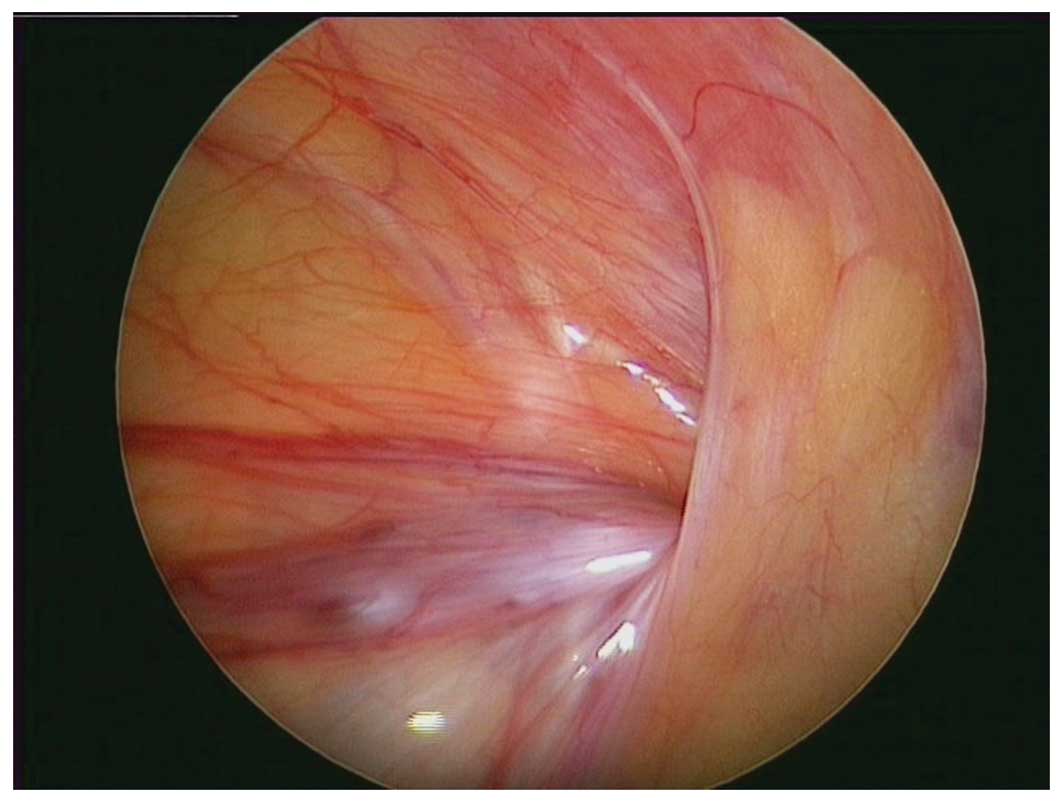|
1
|
Duckett JW: Treatment of congenital
inguinal hernia. Ann Surg. 135:879–885. 1952. View Article : Google Scholar : PubMed/NCBI
|
|
2
|
Rothenberg RE and Barnett T: Bilateral
herniotomy in infants and children. Surgery. 37:947–950.
1955.PubMed/NCBI
|
|
3
|
Nataraja R and Mahomed A: Systematic
review for paediatric metachronous contralateral inguinal hernia: a
decreasing concern. Pediatr Surg Int. 27:953–961. 2011. View Article : Google Scholar : PubMed/NCBI
|
|
4
|
Lee DG, Park KH and Baek M: The
possibility of contralateral occurrence after unilateral hydrocele
or inguinal hernia repair in children. Korean J Ped Urol. 2:43–46.
2010.(In Korean).
|
|
5
|
Miltenburg DM, Nuchtern JG, Jaksic T, et
al: Laparoscopic evaluation of the pediatric inguinal hernia - a
meta-analysis. J Pediatr Surg. 33:874–879. 1998. View Article : Google Scholar : PubMed/NCBI
|
|
6
|
Lobe TE and Schropp KP: Inguinal hernias
in pediatrics: initial experience with laparoscopic inguinal
exploration of the asymptomatic contralateral side. J Laparoendosc
Surg. 2:135–141. 1992. View Article : Google Scholar : PubMed/NCBI
|
|
7
|
Chu CC, Chou CY, Hsu TM, et al:
Intraoperative laparoscopy in unilateral hernia repair to detect a
contralateral patent processus vaginalis. Pediatr Surg Int.
8:385–388. 1993. View Article : Google Scholar
|
|
8
|
Lee SL, Sydorak RM and Lau ST:
Laparoscopic contralateral groin exploration: is it cost effective?
J Pediatr Surg. 45:793–795. 2010. View Article : Google Scholar : PubMed/NCBI
|
|
9
|
Sözübir S, Ekingen G, Senel U, Kahraman H
and Güvenç BH: A continuous debate on contralateral processus
vaginalis: evaluation technique and approach to patency. Hernia.
10:74–78. 2006. View Article : Google Scholar
|
|
10
|
Ron O, Eaton S and Pierro A: Systematic
review of the risk of developing a metachronous contralateral
inguinal hernia in children. Br J Surg. 94:804–811. 2007.
View Article : Google Scholar : PubMed/NCBI
|
|
11
|
Miltenburg DM, Nuchtern JG, Jaksic T, et
al: Meta-analysis of the risk of metachronous hernia in infants and
children. Am J Surg. 174:741–744. 1997. View Article : Google Scholar : PubMed/NCBI
|
|
12
|
Godbole PP and Stringer MD: Patent
processus vaginalis. Pediatric Urology. Gearhart JP, Rink RC and
Mouriquand PDE: Saunders/Elsevier; Philadelphia: pp. 577–584. 2010,
View Article : Google Scholar
|
|
13
|
Nguyen HT: Hernia, hydroceles, testicular
torsion, and varicocele. The Kelalis-King-Belman Textbook of
Clinical Pediatric Urology. Docimo SG, Canning DA and Khoury AE:
Informa Healthcare: London: pp. 1271–1293. 2007
|
|
14
|
Burgu B, Baker LA and Docimo SG:
Cryptorchidism. Pediatric Urology. Gearhart JP, Rink RC and
Mouriquand PDE: Saunders; Philadelphia: pp. 563–576. 2010,
View Article : Google Scholar
|
|
15
|
Luo CC and Chao HC: Prevention of
unnecessary contralateral exploration using the silk glove sign
(SGS) in pediatric patients with unilateral inguinal hernia. Eur J
Pediatr. 166:667–669. 2007. View Article : Google Scholar : PubMed/NCBI
|
|
16
|
Mollen KP and Kane TD: Inguinal hernia:
what we have learned from laparoscopic evaluation of the
contralateral side. Curr Opin Pediatr. 19:344–348. 2007. View Article : Google Scholar : PubMed/NCBI
|
|
17
|
Schier F, Danzer E and Bondartschuk M:
Incidence of contralateral patent processus vaginalis in children
with inguinal hernia. J Pediatr Surg. 36:1561–1563. 2001.
View Article : Google Scholar : PubMed/NCBI
|
|
18
|
Rowe MI, Copelson LW and Clatworthy HW:
The patent processus vaginalis and the inguinal hernia. J Pediatr
Surg. 4:102–107. 1969. View Article : Google Scholar : PubMed/NCBI
|
|
19
|
Rathauser F: Historical overview of the
bilateral approach to pediatric inguinal hernias. Am J Surg.
150:527–532. 1985. View Article : Google Scholar : PubMed/NCBI
|
|
20
|
Lotan G, Efrati Y, Stolero S and Klin B:
Transinguinal laparoscopic examination: an end to the controversy
on repair of inguinal hernia in children. Isr Med Assoc J.
6:339–341. 2004.PubMed/NCBI
|
|
21
|
Bhatia AM, Gow KW, Heiss KF, et al: Is the
use of laparoscopy to determine presence of contralateral patent
processus vaginalis justified in children greater than 2 years of
age? J Pediatr Surg. 39:778–781. 2004. View Article : Google Scholar : PubMed/NCBI
|
|
22
|
Eller Miranda M and Duarte Lanna JC:
Videolaparoscopy of the contralateral internal inguinal ring via
the hernia sac in children with unilateral inguinal hernia-initial
experience in Brazil, with a meta-analysis. Pediatr Surg Int.
18:463–469. 2002. View Article : Google Scholar : PubMed/NCBI
|
|
23
|
Geisler DP, Jegathesan S, Parmley MC, et
al: Laparoscopic exploration for the clinically undetected hernia
in infancy and childhood. Am J Surg. 182:693–696. 2001. View Article : Google Scholar
|
|
24
|
Pavlovich CP, Gmyrek GA, Gardner TA, et
al: Flexible transinguinal laparoscopy to assess the contralateral
ring in pediatric inguinal hernias. Tech Urol. 4:141–144.
1998.PubMed/NCBI
|
|
25
|
Rescorla FJ, West KW, Engum SA, et al: The
‘other side’ of pediatric hernias: the role of laparoscopy. Am
Surg. 63:690–693. 1997.PubMed/NCBI
|
|
26
|
Zitsman JL: Transinguinal diagnostic
laparoscopy in pediatric inguinal hernia. J Laparoendosc Surg.
6(Suppl): S15–S20. 1996.PubMed/NCBI
|
|
27
|
Liu C, Chin T, Jan SE and Wei C:
Intraoperative laparoscopic diagnosis of contralateral patent
processus vaginalis in children with unilateral inguinal hernia. Br
J Surg. 82:106–108. 1995. View Article : Google Scholar : PubMed/NCBI
|











